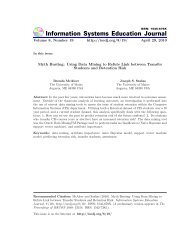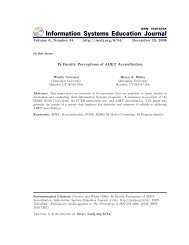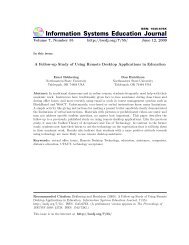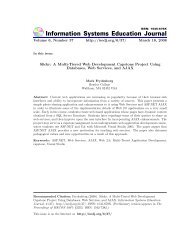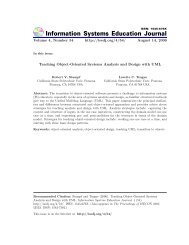Teaching Relational Algebra and Relational Calculus: A ...
Teaching Relational Algebra and Relational Calculus: A ...
Teaching Relational Algebra and Relational Calculus: A ...
Create successful ePaper yourself
Turn your PDF publications into a flip-book with our unique Google optimized e-Paper software.
ISEDJ 6 (9) McMaster, Anderson, <strong>and</strong> Blake 10<br />
APPENDIX B: RELATIONAL CALCULUS PROJECT<br />
This project is intended to help you underst<strong>and</strong> how relational calculus provides a nonprocedural<br />
query language for relational databases. You will examine an implementation of relational<br />
calculus using predicates <strong>and</strong> rules in Turbo Prolog. The Prolog language is based on<br />
predicate calculus, which is a form of deductive logic.<br />
In this project, you will use a Turbo Prolog definition of four tables from the DreamHome Rental<br />
Database (Connolly, 2005). You will perform eight queries on this database using Prolog's version<br />
of relational calculus.<br />
The Turbo Prolog program files you will need can be downloaded from the Internet. The<br />
DHRENTAL.PRO text file you will be given contains slightly modified BRANCH, STAFF,<br />
OWNER, <strong>and</strong> PROPERTY tables of the DreamHome database, expressed as a Prolog program.<br />
Write a new Prolog program that "includes" DHRENTAL.PRO. In your program you are to define<br />
a predicate for each query. Then write one or more relational calculus statements (Prolog<br />
rules) for each query. Your predicate for each query acts like a database view. You can then run<br />
each query as a Goal in the Turbo Prolog Dialog window <strong>and</strong> see the resulting output.<br />
1. List the branch number <strong>and</strong> street for all branch offices that are either in Aberdeen or<br />
Glasgow.<br />
2. List the staff number, last name, position, <strong>and</strong> salary for all staff members that are female <strong>and</strong><br />
earn less than 15,000 (British) pounds per year.<br />
3. List the last name, position, branch number, <strong>and</strong> city for all staff members that don't work in<br />
the city of London.<br />
4. List the property number, city, rooms, rent, <strong>and</strong> staff number for all rentals that have at least 4<br />
rooms <strong>and</strong> are listed by a female staff member.<br />
5. List the property number, type, rent, <strong>and</strong> branch number for all rentals that are either located<br />
in London or listed with the branch in Aberdeen.<br />
6. List the first name <strong>and</strong> last name of staff members who work in London <strong>and</strong> of owners who<br />
own property in London.<br />
7. List the client number, first name, last name, <strong>and</strong> property number of clients who have<br />
viewed a property in Glasgow.<br />
8. For all clients, list the client number, preferred type, maximum rent, property number, <strong>and</strong><br />
actual rent for all properties of the client's preferred type in which the actual rent does not<br />
exceed the client's maximum rent <strong>and</strong> is also less than 400 pounds.<br />
Turn in printouts of the following:<br />
1. Your Prolog program that "includes" the DHRENTAL.PRO program <strong>and</strong> lists your Prolog<br />
statements for each query.<br />
2. The output for each query.<br />
c○ 2008 EDSIG http://isedj.org/6/9/ February 7, 2008



